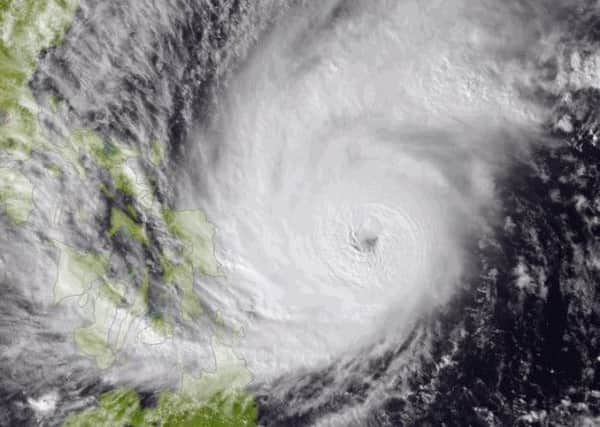Philippines braced as Typhoon Hagupit powers in


Rescue teams said they would have to wait for the storms to clear the area, which forecasters warned could take most of today, before getting in to assess the damage and potential loss of life.
Typhoon Hagupit slammed into the central Philippines’ east coast, knocking out power and toppling trees even before it reached peak strength, in a region where 650,000 people have fled in hope of finding safety, still haunted by the death and destruction wrought by last year’s Typhoon Haiyan storm.
Advertisement
Hide AdAdvertisement
Hide AdIn the central city of Tacloban, where Haiyan storm surges killed thousands of people and levelled villages, news of the approaching typhoon rekindled painful memories. Many residents fled to storm shelters, a sports stadium and churches even before officials urged them to seek refuge.
“I’m scared,” said Haiyan survivor Jojo Moro. “I’m praying to God not to let another disaster strike us again. We haven’t recovered from the first.”
The 42-year-old businessman, who lost his wife, daughter and mother last year in Tacloban, said he stocked up on sardines, instant noodles, eggs and water.
Packing powerful winds of 109mph with gusts of 130mph, Hagupit made landfall in Dolores, a coastal town facing the Pacific in Eastern Samar province, according to the Philippines’ weather agency. There were no immediate reports of casualties.
Although most hope it won’t reach the unprecedented strength of Haiyan, Hagupit’s strong winds and heavy rain were enough to cause major damage to an impoverished region still reeling from the devastating November 2013 storm, which left more than 7,300 people dead or missing.
“There are many trees that have toppled, some of them on the highway,” police inspector Alex Robin said from Dolores, hours before Hagupit hit land. “We are totally in the dark here. The only light comes from flashlights.”
From Eastern Samar, Hagupit – Filipino for “smash” or “lash” – was expected to hammer parts of a string of island provinces that were devastated by Haiyan’s tsunami-like storm surges and ferocious winds.
Robin said about 600 families had sought refuge in Dolores’ municipal hall, one of many emergency shelters in the town.
Advertisement
Hide AdAdvertisement
Hide Ad“Everyone here is just looking for a place to sleep,” he said. “All the windows are closed, but it is still cool because of the wind and the rain.”
Eastern Samar representative Ben Evardone said electricity also was knocked out before the worst of the storms hit Borongan city, about 43 miles south of Dolores, where the government has set up a command centre for rescue and relief operations led by interior minister Mar Roxas.
Evardone said the strong winds also felled trees and ripped off roofing sheets. “You can hear the whistling of the wind,” he said. “Everybody is in fear because of what happened during Haiyan,” he said. “We can already feel the wrath of the typhoon. Everybody is praying.”
Big waves pushed seawater over concrete walls along a boulevard, flooding it, Evardone added.
Troops were sent to supermarkets and major roads in provinces in the typhoon’s path to prevent looting, keep order and to clear debris, all of which slowed the government’s response last year, said General Gregorio Pio Catapang, head of the Philippines’ 120,000-strong military.
“We’re on red alert, so the entire armed forces is being mobilised for this typhoon,” Catapang told a news conference.
While unlikely to reach Haiyan’s strength, forecasters said Hagupit’s maximum sustained winds and gusts were strong enough to set off deadly storm surges and landslides and cause heavy damage to communities and agriculture.
With a whirling band of rain clouds spanning 373 miles, Hagupit gained speed and was moving west, said forecasters.
Advertisement
Hide AdAdvertisement
Hide AdAround 650,000 people have been moved to safety, including in Tacloban. A United Nations humanitarian agency spokesman, Denis McClean, said in Geneva it was one of the largest peacetime evacuations in Philippine history. It also was reminiscent of the evacuation of one million people along India’s coastline before Cyclone Phailin hit in October last year.
Nearly 100 domestic flights were cancelled and inter-island ferry services suspended.
Rommel Sotto, Save the Children’s emergencies manager, said: “This is the most unpredictable storm I’ve experienced. We urgently need to know where it is going to make landfall so we can reach people affected as quickly as possible.”
Sarah Dransfield, for Oxfam, said Hagupit was expected to be “category 3 or 4 which isn’t as strong as Haiyan, but the problem is it is moving much slower. [So] wind and rain are impacting an area for longer.
“At least this time a lot of people have been evacuated.”